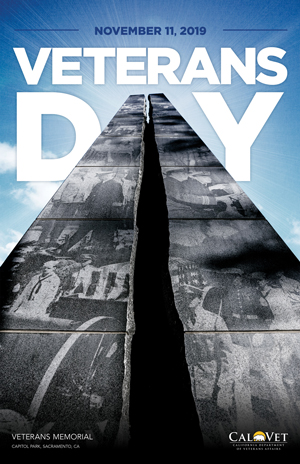November 11, 2019 - By They say a picture is worth a thousand words. The dozens of images etched onto the California Veterans Memorial in downtown Sacramento’s Capitol Park say  not only a thousand words, but might also leave visitors with a thousand questions.
not only a thousand words, but might also leave visitors with a thousand questions.
(Left) The poster reflects the image of the 28-foot obelisk known as California’s Veterans Memorial at Capitol Park in Sacramento.
Who were the men and women depicted on the 28-foot-tall obelisk? Where and when did they serve? Which wars and conflicts are represented? And what about the monument itself? How did it come to be?
The story behind the California Veterans Memorial – known informally as the All-Veterans Memorial – is full of intrigue, irony, and emotions.
The Memorial was dedicated among speeches and somber embraces in December 1998. A stunning photo of the monument, taken by Thomas Moralez of the California Department of Veterans Affairs, graces CalVet’s 2019 Veterans Day poster.
Like some other memorials, the Veterans Memorial took more than a decade to become a reality, from concept to commissioning, to capitalization, to christening.
The project began in the mid-1980s, as the construction of the California Vietnam Veterans Memorial, about 150 yards away, wound down. When the Vietnam Memorial Commission dissolved, the legislature created a commission to oversee fundraising and construction of the California Veterans Memorial, to honor all California veterans.
The $739,000 remaining in the Vietnam Veterans Memorial account became the initial funding for what was projected to be a $5 million veterans wall. But that turned into a fiscal and organizational quagmire that saw much of the money spent on salaries, a lawsuit and accompanying legal expenses, and other unnecessary expenditures. The problems impacted fundraising efforts as the project was downscaled to less than $800,000.
Marine veteran and then-Governor Pete Wilson replaced the majority of commission members, and appointed Michael Kilbane of CalVet as the project director.
Kilbane saved the project and got it built, said Don Carmickle, who was involved in the project. “That was his baby,” Carmickle said.
Carmickle owns Previsualists Unlimited, a Sacramento-area company that specializes in 3D imagery, photosimulations, and other highly technical processes. He sorted through thousands of photographs to find the ones from which he created negatives. Those negatives then went to a company which created the stencils that became the patterns for the sandblasted etchings on the monument’s black granite panels.
“It was the largest sandblasting etching up to that time,” Carmickle said. It was quickly surpassed in size by the Korean War Memorial on the Washington, D.C. mall, commissioned around the same time but dedicated 29 months before the California Veterans Memorial.
The California monument creators wanted to depict all five branches of the service.
”We needed to get everybody represented,” Carmickle said. “We needed a diversity of veterans. We needed women, and veterans from all races.”
Each face of the monument would display a different aspect of war: Combat, ceremonies, daily duties, and the home front. It was a highly technical undertaking that required incredible attention to detail, from what would be depicted in the etchings to how the work was performed.
Many of the photographs summited simply were not suitable for negatives. For a photo of a woman, he found a photo of his mother, Mary, who had been a Marine. And just when he thought he’d met all of the commission’s requirements, another would arise.
“They came back and said, ‘We don’t have enough Native Americans. And we don’t have enough pilots,’ ” Carmickle said. “I’m thinking, ‘How are we going to do that?’ ”
But, just as every project can have its frustrations, it can also benefit from lucky breaks where things fall into place. That happened for Carmickle and the Memorial one day when a man walked into his shop wanting to have a photo restored.
“He had a picture of himself and his war buddies,” Carmickle said. “He was Native American. And a pilot. We needed Native Americans. We needed pilots.”
Problem solved: The gent allowed him to use the photo on the memorial.
The giant slabs of black granite were transported to a warehouse in Sacramento, where the sandblasting was done. They were then mounted onto the obelisk. The etchings matched up perfectly, as photos literally rounded the corners. The absolute precision of the finished product both gratified and surprised some of those involved, Carmickle included.
“Everything had to line up to perfection, and there were no glitches whatsoever,” he said.
The dedication took place on December 12, 1998. A Sacramento Bee story told of speeches, patriotic music performed by an Army band, and contributors also attended.
“… but the real heart of Saturday’s dedication was in the audience,” the Bee’s Wayne Wilson wrote.
He told of a Korean War veteran who came to pay respects to fellow Marines who died at Chosin Reservoir in 1954. He told of a Sacramento woman there to honor the memory of her parents who survived the attack on Pearl Harbor in 1941. And he told of a Huntington Beach woman who attended the dedication to draw attention to the nation’s 1.2 million women veterans (at the time) who are “underrepresented and underserved as far as veterans benefits go,” she said.
Their testimonies represented why we build memorials: to remember, to reflect, and to respect. The creators of the California Veterans Memorial overcame great obstacles to finish the project, and Kilbane – the project manager – deserved the greatest kudos for making it finally happen. He later shared an award with CalVet official Steve Dakota for a documentary made of the dedication.
Kilbane, a US Navy veteran, went on to become CalVet’s director of cemeteries and memorials, overseeing the creation of the Northern California Veterans Cemetery at Igo, near Redding, and began working on the California Central Coast Veterans Cemetery at Seaside, which opened in 2016 and last month earned an honor from the federal VA’s National Cemetery Administration. But Kilbane didn’t get to see that project to completion.
He suffered an apparent heart attack and died outside of the State Capitol – and not far from the California Veterans Memorial – in February 2001, just over two years after the Memorial’s dedication.
It stands there now in Capitol Park as a monument to all Californian veterans, and a gallery of pictures worth thousands of words with just as many questions.
Source: CalVet









